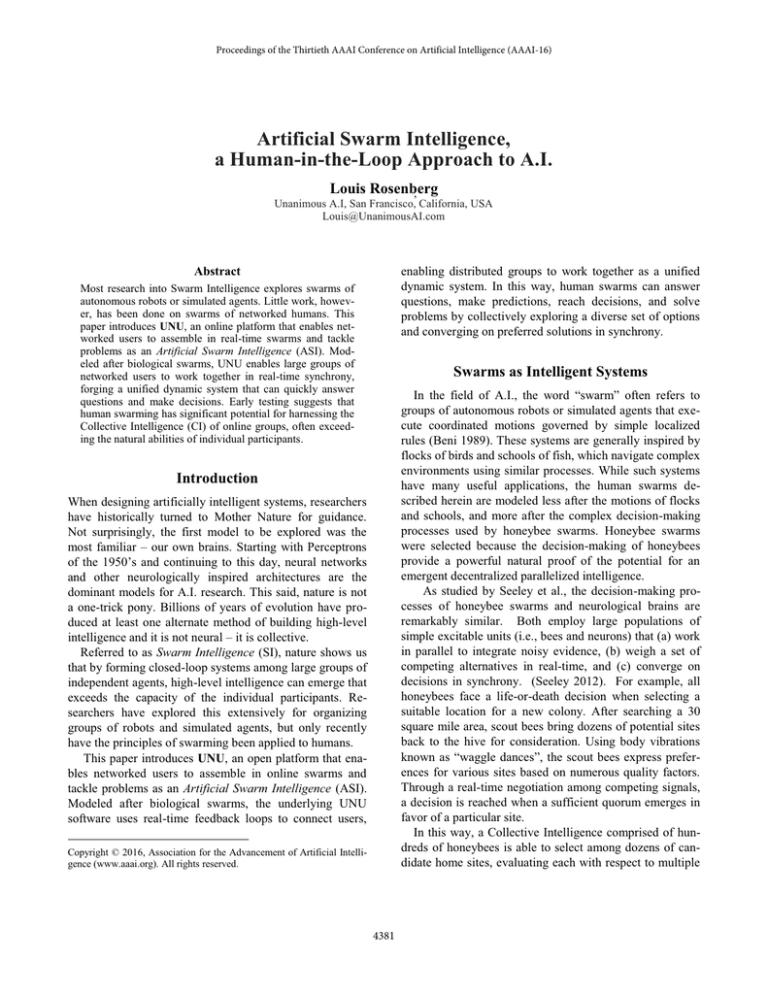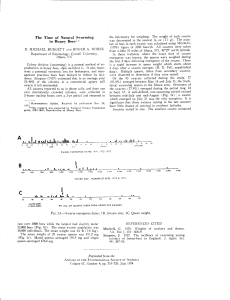
Proceedings of the Thirtieth AAAI Conference on Artificial Intelligence (AAAI-16)
Artificial Swarm Intelligence,
a Human-in-the-Loop Approach to A.I.
Louis Rosenberg
,
Unanimous A.I, San Francisco, California, USA
Louis@UnanimousAI.com
enabling distributed groups to work together as a unified
dynamic system. In this way, human swarms can answer
questions, make predictions, reach decisions, and solve
problems by collectively exploring a diverse set of options
and converging on preferred solutions in synchrony.
Abstract
Most research into Swarm Intelligence explores swarms of
autonomous robots or simulated agents. Little work, however, has been done on swarms of networked humans. This
paper introduces UNU, an online platform that enables networked users to assemble in real-time swarms and tackle
problems as an Artificial Swarm Intelligence (ASI). Modeled after biological swarms, UNU enables large groups of
networked users to work together in real-time synchrony,
forging a unified dynamic system that can quickly answer
questions and make decisions. Early testing suggests that
human swarming has significant potential for harnessing the
Collective Intelligence (CI) of online groups, often exceeding the natural abilities of individual participants.
Swarms as Intelligent Systems
In the field of A.I., the word “swarm” often refers to
groups of autonomous robots or simulated agents that execute coordinated motions governed by simple localized
rules (Beni 1989). These systems are generally inspired by
flocks of birds and schools of fish, which navigate complex
environments using similar processes. While such systems
have many useful applications, the human swarms described herein are modeled less after the motions of flocks
and schools, and more after the complex decision-making
processes used by honeybee swarms. Honeybee swarms
were selected because the decision-making of honeybees
provide a powerful natural proof of the potential for an
emergent decentralized parallelized intelligence.
As studied by Seeley et al., the decision-making processes of honeybee swarms and neurological brains are
remarkably similar. Both employ large populations of
simple excitable units (i.e., bees and neurons) that (a) work
in parallel to integrate noisy evidence, (b) weigh a set of
competing alternatives in real-time, and (c) converge on
decisions in synchrony. (Seeley 2012). For example, all
honeybees face a life-or-death decision when selecting a
suitable location for a new colony. After searching a 30
square mile area, scout bees bring dozens of potential sites
back to the hive for consideration. Using body vibrations
known as “waggle dances”, the scout bees express preferences for various sites based on numerous quality factors.
Through a real-time negotiation among competing signals,
a decision is reached when a sufficient quorum emerges in
favor of a particular site.
In this way, a Collective Intelligence comprised of hundreds of honeybees is able to select among dozens of candidate home sites, evaluating each with respect to multiple
Introduction
When designing artificially intelligent systems, researchers
have historically turned to Mother Nature for guidance.
Not surprisingly, the first model to be explored was the
most familiar – our own brains. Starting with Perceptrons
of the 1950’s and continuing to this day, neural networks
and other neurologically inspired architectures are the
dominant models for A.I. research. This said, nature is not
a one-trick pony. Billions of years of evolution have produced at least one alternate method of building high-level
intelligence and it is not neural – it is collective.
Referred to as Swarm Intelligence (SI), nature shows us
that by forming closed-loop systems among large groups of
independent agents, high-level intelligence can emerge that
exceeds the capacity of the individual participants. Researchers have explored this extensively for organizing
groups of robots and simulated agents, but only recently
have the principles of swarming been applied to humans.
This paper introduces UNU, an open platform that enables networked users to assemble in online swarms and
tackle problems as an Artificial Swarm Intelligence (ASI).
Modeled after biological swarms, the underlying UNU
software uses real-time feedback loops to connect users,
Copyright © 2016, Association for the Advancement of Artificial Intelligence (www.aaai.org). All rights reserved.
4381
options. The options can be provided up-front by the asker
or suggested in real-time by the swarm participants.
competing criteria. Remarkably, the bees arrive at optimal
decision more than 80% of the time (Seeley 2010). It is this
distributed emergent process that the UNU platform aims
to enable among groups of networked people.
UNU, a platform for Human Swarming
To foster an emergent Artificial Swarm Intelligence
among groups of networked users, an online platform was
modeled after natural swarms. The underlying code allows
a group of independent actors to work together in parallel
to (a) integrate noisy evidence, (b) weigh competing alternatives, and (c) converge on final decisions. Because humans can’t waggle dance like honeybees, a novel interface
had to be developed to allow participants to convey their
individual intent with respect to a set of alternatives. In
addition, the interface had to be crafted to allow users to
perceive and react to the changing system in real-time,
thereby closing a feedback loop around the full population.
Logging into a central server, users from around the
globe answer questions as a unified swarm by collectively
moving a graphical puck to select among provided alternatives. The puck is modeled as a physical system with a
defined mass, damping and friction. Each user provides
input using a graphical magnet controlled by their mouse
or touchscreen. By positioning their magnet relative to the
puck, each user can impart his or her personal intent as a
unique force vector to be applied to the puck (Figure 1).
Figure 2. A real-time Human Swarm answering a question.
After the question and choices are displayed to all users,
the puck appears at the center of the screen. The swarm
then springs into action, working in synchrony to guide the
puck to a preferred answer. The decision process is generally a complex negotiation, with individuals shifting their
position numerous times to settle deadlocks or defend
against options they disfavor. When a user pulls towards
one option in the answer set, a component of their force
also acts to impede the motion of the puck towards competing options. In this way, users don’t only add support a
preferred solution when pulling towards it, but also help to
suppress solutions they don’t prefer. This enables the dual
processes seen in natural swarms and neurological brains
wherein individual agents are enabled to both excite and
inhibit, thereby reducing the chances of a deadlock.
Pilot tests of artificial human swarms have demonstrated
accurate predictions and estimations, outperforming votes
and polls and other traditional methods of harnessing the
collective intelligence of groups (Rosenberg 2015). To
support the ongoing study of human swarms, the UNU
platform is available to researchers who wish to run their
own experiments. For access, visit: unanimous.ai
Figure 1. A real-time Human Swarm.
The input from each user is not a discrete vote, but a
continuous stream of intent vectors that vary freely over
the decision process. With every member adjusting their
intent at every time-step during the decision, the puck
moves, not based on the input of any individual, but based
on the changing dynamics of the full system. This results
in a real-time physical negotiation among all the members
of the swarm as they collectively explore the decisionspace and converge upon the most agreeable answer.
Figure 2 below shows an example question as it would
appear simultaneously on the screens of all users in the
swarm. In this example, a swarm of 90 users were given a
politically charged question: “What should be Congress’s
top priority?” This was presented along with six answer
References
Beni, G., Wang, J. Swarm Intelligence in Cellular Robotic Systems, Proceed. NATO Advanced Workshop on Robots and Biological Systems, Tuscany, Italy (1989).
Seeley, Thomas D., et al. "Stop signals provide cross inhibition in
collective decision-making by honeybee swarms." Science
335.6064 (2012): 108-111.
Seeley, Thomas D. Honeybee Democracy. Princeton University
Press, 2010.
Rosenberg, L.B., “Human Swarms, a real-time method for Collective Intelligence.” Proceedings of the European Conference on
Artificial Life 2015, pp. 658-659.
4382




